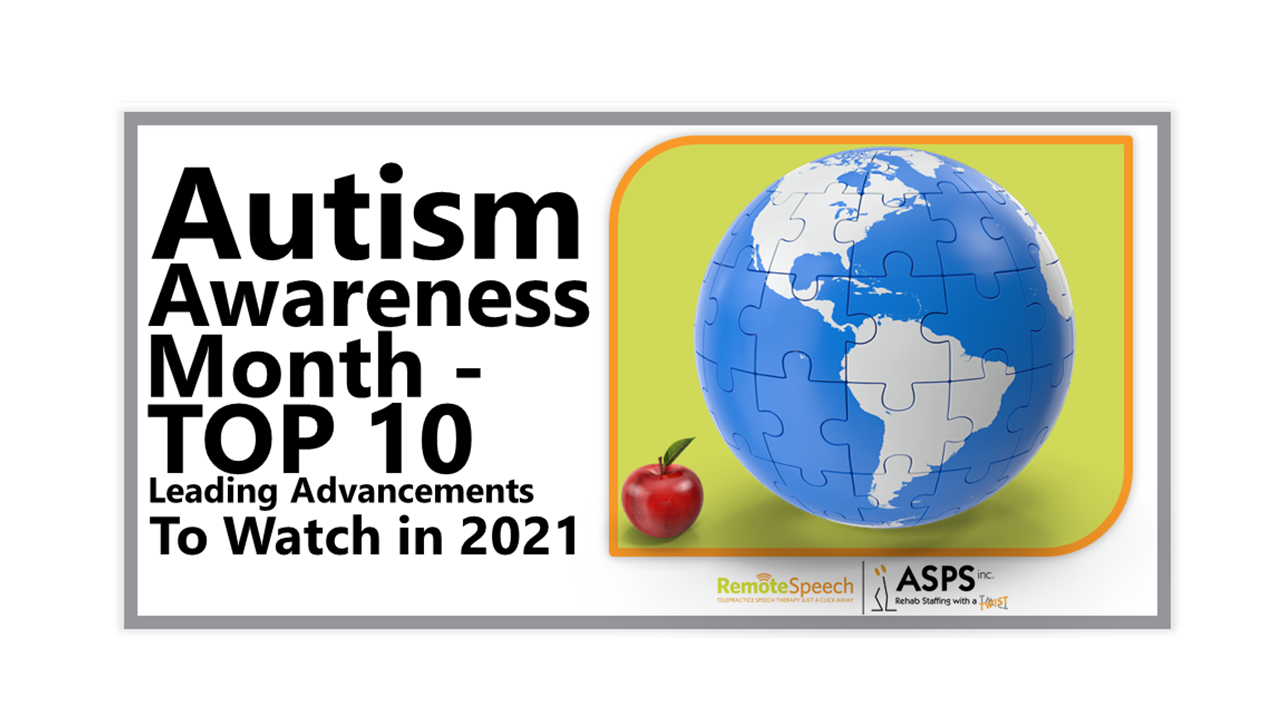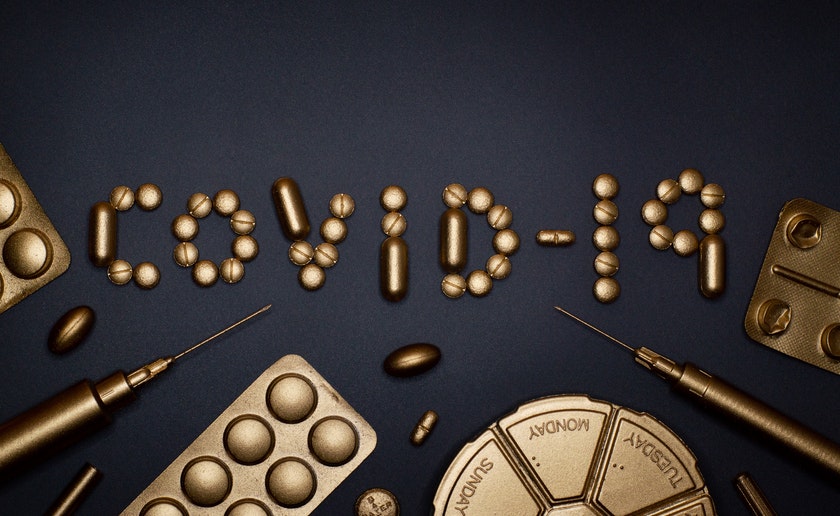
14
Apr
Autism Awareness Month – Top 10 Leading Advancements to Watch in 2021
The month of April is recognized worldwide for Autism Awareness. This year’s observance is unlike any we’ve experienced – with a global pandemic and lockdowns that temporarily suspended EVERYTHING. However, despite the adversity and challenges, the world of Autism treatment and research has still managed to thrive.
In this article, we are going to take a look at developments made in the past year for the field of Autism, whether it be related to exciting developments, research, treatment, and our general understanding of the spectrum’s diversity. We will provide a summary of the subject, a description of its potential impact, and helpful links for you to follow for further research. We can say, with absolute certainty, that the dedicated researchers and educators related to Autism were not discouraged or slowed down in the slightest!
Here is our list of the top 10 most exciting developments in the world of Autism!
10. DISCOVERIES - MYELIN.
According to research published in the journal Nature Neuroscience, autism spectrum disorder affects the brain’s production of myelin, impacting the movement of signals through the brain. Myelin insulates the nerves in the brain and spinal cord and enables the quick transmission of signals along nerves. An overproduction or underproduction of myelin can lead to a variety of neurological conditions. Researchers, excited by the discovery, are saying it could be possible to make these cells “healthier” by using drugs to treat myelination. Dr. Sarah Bauer, a developmental and behavioral pediatrician and a leader in the ECHO Autism program at Advocate Children’s Hospital, also is encouraged by the findings. “As a developmental pediatrician, I think about how our understanding of the ‘why’ connects to what we can do to support children and families we encounter in clinic,” Dr. Bauer says. “If we understand more about why developmental differences like autism occur, the next step is figuring out how we can translate this information into early intervention and support our children’s developmental trajectories.” Dr. Bauer also says this research provides more to support the need for individualized intervention in children. “There is not a ‘one-size-fits-all’ treatment model for autism,” she says. “At a population level, this speaks to why we need to consider more innovative ways to meet the diagnostic and individualized intervention needs for children and families.”Read the full Study Here
9. RESEARCH STRATEGIES - DIVERSIFYING DATA.
Though autism is an extremely diverse condition, the datasets used to study it have been less so. Researchers have been working to include autistic people of different genders, ages, races, and abilities in their studies for some time. This year, many of those efforts came to fruition. To analyze sex differences, one team of geneticists amassed a large cohort of autistic men and women, finding that the condition may originate in a different set of mutations in women than it does in men. Other researchers examined the neurobiological underpinnings of social behavior in autistic girls for the first time. They found that, unlike boys with autism, girls with the condition have strong neural responses to social stimuli in their reward systems — in some cases, even stronger than in girls without autism. After recruiting a large number of girls, another group found that the brain appears to develop differently in girls and boys with autism. That same group also found novel ways to image the brains of autistic people with a low intelligence quotient (IQ) and severe traits. In doing so, they identified an autism subtype marked by an unusually large brain, challenging ideas about brain size in the condition. A genetic study that included autistic people with a broad range of IQs revealed that rare mutations in autism genes are more common among people with lower IQs than among those with higher ones. And the first study to image the brains of minimally verbal autistic people found that they have trouble differentiating the sound of their names from other sounds, providing insights into their language development. Researchers also genetically sequenced a new cohort of African children with autism and their families, conducted Greece’s first autism prevalence study and China’s largest to date, and delved into the diagnostic experiences of Black children with autism. Investigations of adults with autism — another understudied group — showed that they may not experience the usual age-related declines in their ability to understand another person’s mental state and in the strength of connections across the brain’s visual regions. Researchers say that diversifying the people included in autism research will lead to a fuller and more accurate picture of the condition.8. DIAGNOSIS AND TREATMENT - DISCOVERY OF GENETIC “WRINKLES.”
Researchers at The Hospital for Sick Children (SickKids) Toronto, conducted a program that examined the DNA of 10,000 families -- many of whom have children with autism. This research yielded the discovery of “genetic wrinkles” that occur in DNA. This discovery is a breakthrough they believe could explain why some individuals find themselves on the autistic spectrum. The hope is that this could be an important new clue into how to diagnose autism spectrum disorder (ASD) early, or even treat it. Dr. Stephen Scherer is co-author of the study, and director of the Centre for Applied Genomics at SickKids. He explains that “[the discovery] unveils a whole new class of genes that we didn't know (were) involved in autism before,” he said.“We do know that they're involved in brain function but we don't know how they fit into the jigsaw puzzle.” Current research estimates that genetic factors should be found in anywhere from 50 to 90% of individuals with ASD. Scientists already know of about 100 genes that play a role in the development of autism, but these genes only explain less than 20% of cases. In order to delve further into these genetic components, researchers had to “develop new methodologies,” Scherer said. Ryan Yuen, the team leader for this new study, rose to the challenge. Nine years ago, he developed a “new computational approach,” according to Scherer, which allowed him to search for specific characteristics within DNA itself, and compare patterns found within individuals with autism to their parents or “other controls in the population.” Now they’ve discovered that sections of DNA from parents sometimes get doubled -- or, in some cases, tripled -- in their children. These are called “tandem repeat expansions.” Tandem repeats are nucleotides, which are the building blocks of DNA, repeated adjacently, two or more times… they're like DNA wrinkles. When these wrinkled strands of DNA are replicated, the repeat can grow longer, which is why a tandem repeat present in a parent’s DNA could be expanded from parent to child. The larger these wrinkles are, the more likely that they could interfere with gene function. Tandem repeats had been studied before individually, but it was difficult, as they had to be searched for in one gene at a time. Since there can be a million tandem repeats in the genome, according to a press release from SickKids, locating the tandem repeats that actually contribute to ASD “would be like looking for a needle in a haystack.” “In this study, we pioneered a method that can effectively search and analyze terabytes of whole-genome sequencing data for tandem repeat expansions,” Said Yuen. “Many of the genes linked to [these] repeats [were] never thought to be involved in autism before.” Some of the new genes identified included those “involved in the nervous system,” he said. And the location of the tandem repeat expansion within the DNA itself was associated with “certain characteristics and behaviors such as IQ and life skills,” noted the press release. “This really is a game-changer for autism and genomic research. It opens up new opportunities in precision diagnostics and medicine,” Yuen said. Scherer said that in the almost two decades he’s been studying the autism spectrum, “this is the most exciting advance we've had in 15 years.” Yuen believes this research will “impact thousands of families,” and will allow scientists to provide countless individuals with autism a clear explanation for their autism by looking at their genes. The implications of this discovery can not be underestimated. Among them include informing patients and their families early on what type of autism they have, so they can plan for care. The finding may also help scientists find a medication that can target these regions in the DNA itself. Researchers suspect these genetic wrinkles may play a role in other complex conditions related to the brain -- such as epilepsy and schizophrenia.Read the Complete Press Release from AutismSpeaks. Read the Full Study Here
7. DISCOVERY – AUTISM GENES.
Over the past decade, scientists have identified hundreds of genes that, when mutated, can increase a person’s chances of having autism. But several studies this year support the idea that few of these ‘autism’ genes are specific to autism. Autistic people who carry rare, spontaneous mutations in these genes tend to have a lower intelligence quotient than people without such mutations, according to one study. And many of the genes mutated in autistic people are also mutated in people with other neurodevelopmental conditions, including intellectual disability, developmental delay and attention deficit hyperactivity disorder. Most people who carry a mutation in the autism-linked gene DDX3X, for example, have intellectual disability. Part of the overlap may stem from inconsistent or inaccurate diagnoses: Doctors often struggle to discriminate autism from intellectual disability or other related conditions. For instance, one popular autism screening tool misses most toddlers with autism but instead flags most children who actually have intellectual disability. A new test battery that reliably measures the cognitive abilities of people with intellectual disability may help to resolve this diagnostic dilemma. One team made inroads into predicting the effects of mutations in the autism-related gene FMR1. Among boys who carry mutations in this gene, those with autism have about half as much FMRP — the protein encoded by FMR1— as those without autism; and those with severe intellectual disability have even lower levels of the protein. Whether or not someone has autism or a related condition may also reflect a different type of genetic factor — inherited variants. A study of families in Sweden lent support to the idea this year by showing that autism alone is more heritable than autism with intellectual disability. Another 2020 study identified two regions of the genome in particular that seem to harbor inherited variants linked to autism.Read the full Study Here
6. RESEARCH STRATEGIES AND MACHINE LEARNING.
From identifying a new antibiotic to generating the first-ever image of a black hole, machine learning is changing how scientists approach questions in many fields. Autism researchers are being equally creative, using machine-learning methods to improve diagnosis, classify the condition into subtypes and provide support for people on the spectrum. One of the most common applications of machine learning is in making predictions: where and when a hurricane will make landfall, for example, or what the next word in a person’s text message might be. One team has applied similar methods to predict which newborns would later be diagnosed with autism1. The researchers studied the medical records of the parents of nearly 100,000 children born in Israel from 1997 to 2008. About 1,400 of the children went on to be diagnosed with autism. Using a variety of machine-learning techniques, they analyzed the parents’ age, socioeconomic status and medications. The algorithms successfully predicted about one-third of the children’s autism diagnoses. The predictions were strongest when the researchers combined data from both of a child’s parents, rather than from only one parent. The team published their findings in February in European Psychiatry. Predictive algorithms could also be useful for identifying factors that may contribute to autism. For example, the algorithms found an association between autism and the parents’ use of substances such as caffeine and certain antidepressants. Previous research on such drugs’ contribution to autism is mixed.Learn more about these techniques here
5. RESEARCH AND TREATMENT –SOCIAL PROFILES.
Social difficulties have been considered a defining characteristic of autism since Leo Kanner published the first clinical descriptions of the condition in 1943. However, people with autism can show striking variability in social function: Some lack social interest and awareness of other people and have a limited ability to communicate. Others are keenly interested in forming social bonds and readily communicate their needs, thoughts, and emotions. Given these differences, not every person with autism has the same intervention needs — and different supports are more or less effective depending on an individual’s specific pattern of social strengths and limitations. Despite the clear need to better understand differences in social skills in autism, there have been surprisingly few attempts to identify groups of autistic people with similar profiles of strengths and vulnerabilities. Prior studies, although informative, have mostly focused on particular behaviors and characteristics, without considering other important aspects of social functioning1,2,3. Navigating the social world requires a range of basic skills that, if impaired, can create the social difficulties we see in people with autism. These skills include social motivation, or the desire to interact and affiliate with others; social communication, or the ability to convey social and emotional information to others through various means, such as eye contact, facial expression, gestures, body language, and tone of voice; and social recognition, or the ability to perceive and interpret information communicated by other people. Researchers and clinicians have several excellent tools at their disposal to diagnose autism and measure its overall severity, but to better understand an autistic person’s strengths and areas of need, they must also be able to measure essential social skills. Stanford Medical developed the Stanford Social Dimensions Scale (SSDS) specifically for this purpose. As Stanford notes: “We designed the SSDS through an exhaustive review of the literature and in consultation with autism experts and clinicians, and we have shown it is valid and enables a comprehensive assessment of different aspects of social motivation, social communication, and social recognition4. We believe this work represents an important step toward uncovering the origins of social difficulties in autism and informing personalized intervention and case management plans for autistic people. We also believe that this work has the potential to be useful and informative for understanding social functioning across other neurodevelopmental and neuropsychiatric conditions as well.”Learn more about the research deployed using the SSDS here
4. EARLY INTERVENTION
As we have repeatedly stated, it is impossible to overestimate the value of early intervention (both for the treatment of the child as well as their long-term education and development. Perhaps one of the most profound and positive breakthroughs in ASD treatment has been the recognition of this condition, and an emphasis on encouraging parents to bring children in for evaluation. Children can show some of the symptoms of ASD, such as a lack of eye contact, discomfort at physical contact, or a fixation on details and repetitive actions even before they are toddlers. If vigilant parents see some of these behaviors and bring a child in for an evaluation, this can go a very long way towards making ASD much more manageable and giving a child a much better start in life. With professionals evaluating the exact nuance of a child’s ASD, and parents being informed early on what to expect and how to handle it, everything from going to school to learning to read suddenly becomes much more feasible, and the impact of ASD on the child’s life in a negative way can be minimized. Despite the proven benefits of early-intervention, research is still being conducted to drive the message home. For 2020, the science staff and advisors of Autism Speaks drafted their annual list to highlight the top 10 “studies that most powerfully advanced understanding, treatment and support of people on the spectrum.” Three of the 10 were related to advances in screening, diagnosis, and interventions for autism. They include:- Rogers SJ, Yoder P, Estes A, et al. A Multisite Randomized Controlled Trial Comparing the Effects of Intervention Intensity and Intervention Style on Outcomes for Young Children With Autism. J Am Acad Child Adolesc Psychiatry. 2020.
- Mazurek MO, Parker RA, Chan J, Kuhlthau K, Sohl K, for the ECHO Autism Collaborative. Effectiveness of the Extension for Community Health Outcomes Model as Applied to Primary Care for Autism: A Partial Stepped-Wedge Randomized Clinical Trial. JAMA Pediatrics. 2020;174(5):e196306.
- Wood, JJ, Kendall, PC, Wood, et al. Cognitive behavioral treatments for anxiety in children with autism spectrum disorder: A randomized clinical trial. JAMA Psychiatry. (2020) 77(5), 474-483.
Learn more about the benefits of Early Intervention
3. RESEARCH AND TREATMENT – STEM CELL THERAPY.
Umbilical cord blood is normally thrown away at birth. But for World Autism Awareness Day on April 2nd of this year, a team of doctors and scientists are calling on new mothers to collect and save the blood because it could be used for lifesaving – or even life-changing – treatments. A cord blood treatment is starting to give hope to some children with autism. Dr. Omer Bar Yosef, a clinical and research neurobiologist at Sheba Medical Center, Tel Hashomer, has thus far treated 25 children with autism as part of a Phase II trial using a protocol developed at Duke University Medical Center. Patients receive a one-time infusion of their own cord blood cells. “There is no chemotherapy involved, no chemical medications,” explained Dr. Moshe Israeli, who serves as scientific director at Taburit, one of the leaders in the field of umbilical cord blood collection and preservation in Israel. “There is no concern; it’s not risky.” The results in some cases are improved communication and emotional and social responsiveness. “We don’t know 100% why it is working,” Israeli said. “There is a unique type of stem cell in the cord blood. These cells make their way through the blood to the brain, and we think they promote the growth of new synapses in the brain.” Synapses connect neurons in the brain to neurons in the rest of the body. These cord cells can only be found in cord blood; they are not found in adults later in life. “One or two years after treatment, we see through brain imaging that there are more synapses,” Israeli explained. “The treatment influences the brain to grow and become more efficient and have better communication.” While Israel only allows the use of one’s own cord cells or their siblings’ cells, a Phase III trial being run at Duke also allows for the use of third-party cord blood cells, meaning the cells of an unrelated donor that is stored in one of the cord blood banks. In the US, the treatment is already approved for compassionate use. While the results of this study are promising, Stem Cell research has a long and often controversial history. A recent study titled “Cell therapy approaches to autism: a review of clinical trial data” provided a review of such research projects using stem cell therapy, and examined their success and considerations. The study notes: “A number of clinical trials of cell therapies for autism spectrum disorder have been conducted, and some have published their outcomes. This review considers the data that have emerged from this small set of published trials, evaluates their success, and proposes further steps that could be taken if this field of endeavor is to be pursued further. A number of reservations arise from this tranche of studies, specifically the absence of identified therapeutic targets, and deficiencies in the therapeutic approach that is being employed. If this therapeutic direction is to be pursued further, then additional pre-clinical studies are recommended that might lead to improvements in patient stratification, biomarkers, the defined mode of action, and the preparation and identification of the therapeutic cells themselves.”Learn More about Israeli Researchers studying Stem Cell Therapy for the Treatment of Autism HERE Learn More about the overview study of stem cell research here.
2. TECHNOLOGY.
The Covid pandemic has taught us many things (including a seemingly “accidental” discovery that came with remote treatment). More than ever, we are learning the critical role of technology in the diagnosis and long-term treatment of children on the spectrum. Orna Kempler-Azulay is President and CEO of Abington Speech Pathology Services., INC. and RemoteSpeech, LLC. She began to address industry challenges about 5 years ago, as she began to identify problems that are still pervasive today. “We had a nationwide growing demand for speech pathology services for children across the spectrum. The problem was that this demand was growing at a rate that far-outpaced the availability of licensed specialists that were available to deliver treatment.” The shortage is still prevalent to the present day. According to the Bureau of Labor Statistics, the industry has a projected job growth of 21% through 2024. As with most things, when shortages occur, those most impacted are those with the least amount of resources (in this case, amongst children residing in rural and metro areas.) Azulay launched RemoteSpeech.com to account for these disparities. RemoteSpeech.com has pioneered the delivery of speech therapy in an online environment, that connects the nation’s leading Speech-Language Pathologists and school psychologists with children, adults, and educators for live, face-to-face interactions for the delivery of speech therapy. But there was still more work to be done. While traditional challenges for children with special needs (such as the national shortage of certified Speech-Language Pathologists and a low student reach) had been mitigated with the service delivery model developed by RemoteSpeech, Kempler-Azulay began to identify additional challenges towards the start of the Covid pandemic, specific to remote learning and therapy. When Covid 19 arrived in 2020, parents, students and school administrators were left scrambling to migrate students and staff online. Kempler-Azulay was able to use her five years of experience and success in online treatment to help counsel school districts. “We offered our services and consult to numerous public school districts and private individuals anywhere, that were in need of help in dealing with children with special needs,” recalls Kempler-Azulay. Among these challenges were school districts’ ability to vet quality service providers and to provide quality therapy using adaptive learning. Resources for quality therapy sessions were highly inadequate and limited. Management for treatment programs became difficult to track, progress reports were often difficult to secure and billing processes were cumbersome. Kempler-Azulay and RemoteSpeeech.com took these challenges head-on, and in 2020, launched “VirtualTx” as a direct response. VirtualTx is a cloud-based software application web portal for all things related to service delivery of Speech Pathology– including assessments, evaluations, treatment, and service management. VirtualTx borrows from the virtual features of RemoteSpeech for telepractice, and the staffing expertise of Abington Speech Pathology, to create a “one-stop-shop” for virtual therapy in one user-friendly online environment that is interactive, engaging, and effective – and in many cases, is able to outperform the alternative of treatment in-person. “We created VirtualTx based upon the operational challenges that patients, parents, therapists, and school districts encounter with programs for children that have special needs,” explains Kempler-Azulay. “VirtualTx is cloud-based. Users can access VirtualTx with any device and internet connection – with technology that is in compliance with HIPPA. We are looking forward to seeing the impact that VirtualTx will have, specifically as it relates to children that are still without treatment.”Learn More about VirtualTx here
1.EDUCATION AND AWARENESS.
Awareness of autism spectrum disorder (ASD) has grown dramatically in recent years, which reflects an increase in autism tests and diagnoses — and in the public’s understanding that, even late in life, an autism diagnosis can offer major benefits and relief. We believe that the number one advancement in the world of Autism is Education and Awareness. Every time we learn about Autism, we are better equipped to support those on the spectrum and their community. Check out some of our favorite resources to stay up-to-date on the latest news for Autism Spectrum Disorders!-
Autism Speaks
-
Autism Society
-
American Autism Association
-
The Autism Research Institute
-
HealthyChildren.org





